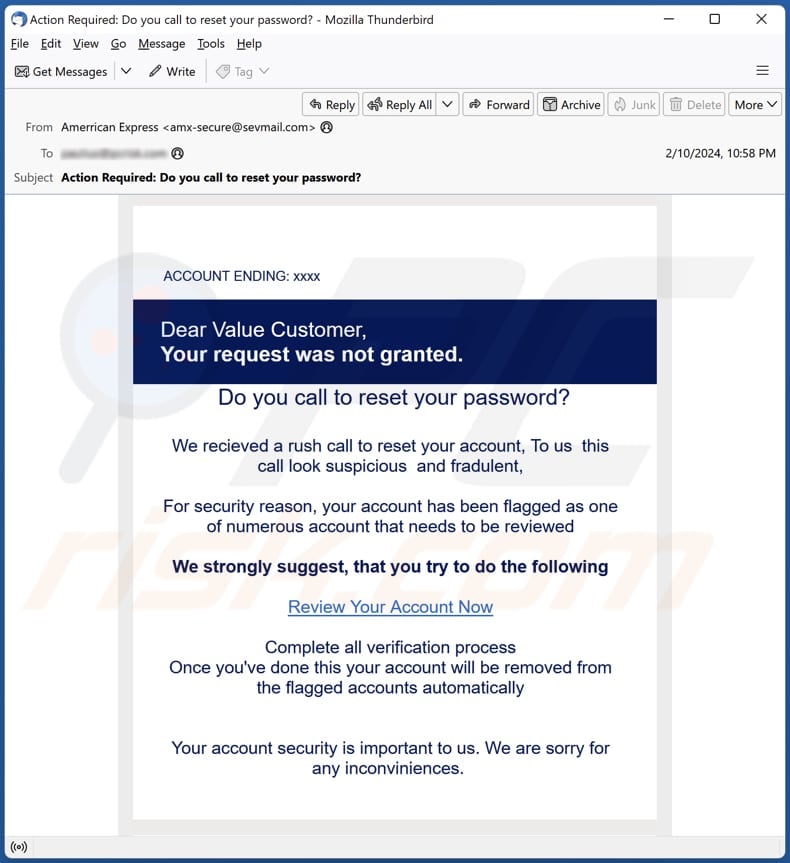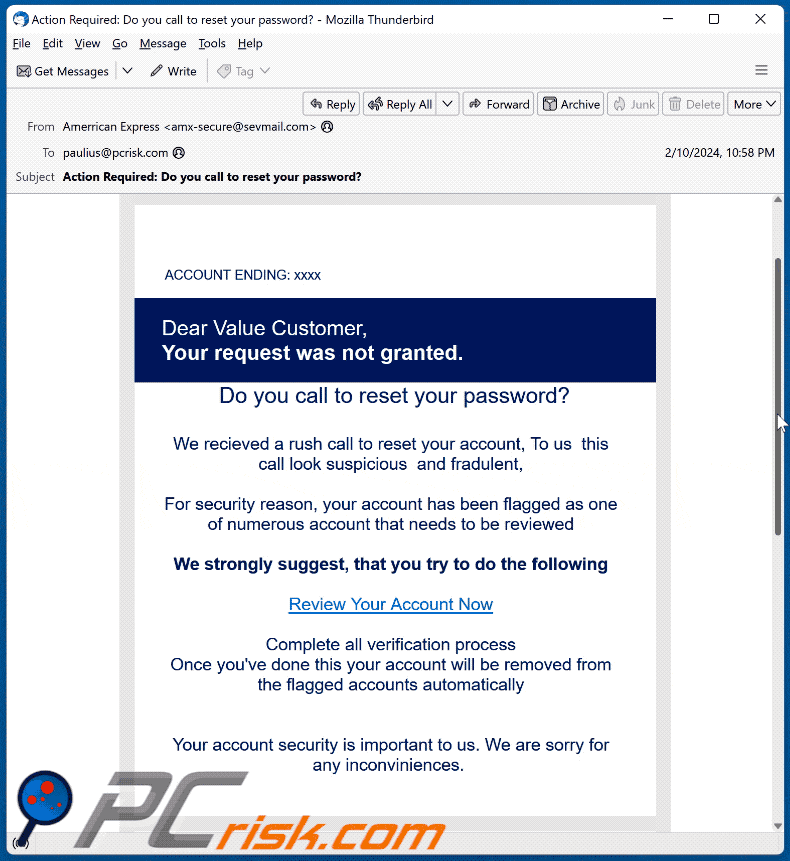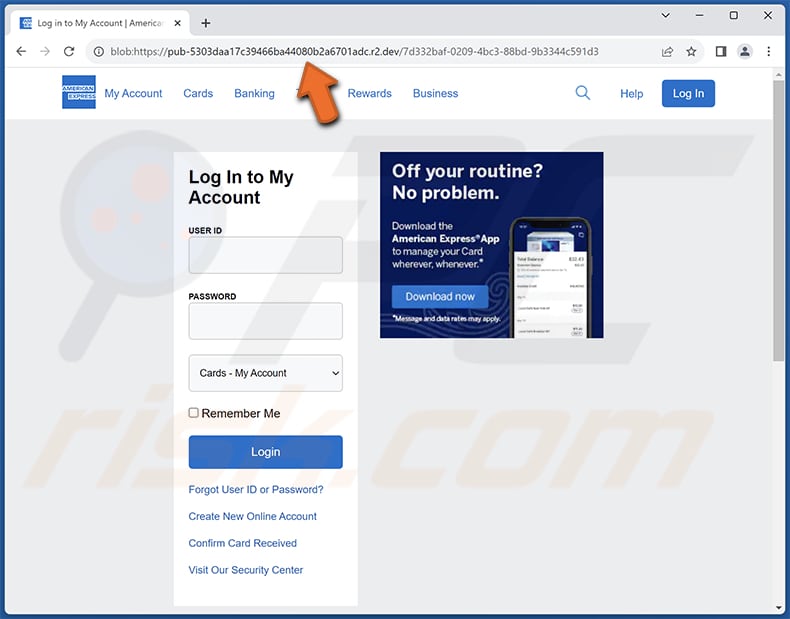How to avoid falling for scams like "American Express - Call to Reset Your Account"
Phishing/ScamAlso Known As: American Express - Call to Reset Your Account phishing email
Get free scan and check if your device is infected.
Remove it nowTo use full-featured product, you have to purchase a license for Combo Cleaner. Seven days free trial available. Combo Cleaner is owned and operated by RCS LT, the parent company of PCRisk.com.
What is "American Express - Call to Reset Your Account"?
Upon scrutinizing the email, we have found it to be a fraudulent notification purportedly from American Express. Crafted by scammers, it intends to entice recipients to access a deceptive website and divulge their personal information. Such emails fall under the category of phishing attempts.

More about the "American Express - Call to Reset Your Account" scam email
This phishing email urges the recipient to take immediate action regarding their account security. The subject line implies that there is an urgent need to reset the password. The body of the email begins with a greeting addressing the recipient as a "Value Customer" and states that a request made by the recipient was not granted.
It then asks if the recipient initiated a call to reset their password, suggesting suspicious activity. The email continues by claiming that the recipient's account has been flagged for review due to security reasons and provides a link to purportedly review the account and complete a verification process.
The email emphasizes the importance of account security and apologizes for any inconvenience caused. It concludes with a signature from "The American Express Fraud Protection Team" and offers an option to unsubscribe from the alerts by clicking a link. Overall, the email is designed to create a sense of urgency and fear of potential account compromise, leading the recipient to click on the provided link.
When the "Review Your Account Now" link is clicked, it opens to a fake American Express login page. On this deceptive page, individuals are prompted to enter their user ID and password. The details entered are then transmitted to scammers, who can exploit them for nefarious activities.
Scammers may misuse the obtained login information to gain unauthorized access to the victim's American Express account, potentially stealing funds, making fraudulent purchases, or accessing sensitive personal information.
They may also sell the stolen login information on the dark web to other criminals, who may use it for identity theft, account takeover attacks, or to perpetrate further scams against the victim or others. Thus, recipients should never respond to suspicious emails or provide personal information on associated pages.
| Name | American Express - Call to Reset Your Account Email Scam |
| Threat Type | Phishing, Scam, Social Engineering, Fraud |
| Fake Claim | There is an urgent need to reset the account password |
| Disguise | Letter from American Express |
| Symptoms | Unauthorized online purchases, changed online account passwords, identity theft, illegal access of the computer. |
| Distribution methods | Deceptive emails, rogue online pop-up ads, search engine poisoning techniques, misspelled domains. |
| Damage | Loss of sensitive private information, monetary loss, identity theft. |
| Malware Removal (Windows) |
To eliminate possible malware infections, scan your computer with legitimate antivirus software. Our security researchers recommend using Combo Cleaner. Download Combo CleanerTo use full-featured product, you have to purchase a license for Combo Cleaner. 7 days free trial available. Combo Cleaner is owned and operated by RCS LT, the parent company of PCRisk.com. |
Similar emails in general
Emails of this type often have urgent or alarming subject lines, urging recipients to take immediate action. They typically impersonate reputable organizations and request personal or financial information. Additionally, they often contain grammatical errors, inconsistencies in branding, and suspicious links or attachments.
The purpose of phishing emails is to deceive recipients into divulging sensitive information such as passwords, credit card numbers, or login credentials. This information is then used by cybercriminals for fraudulent activities, including identity theft, financial fraud, and unauthorized access to accounts.
Examples of phishing campaigns are "OneDrive - You Received Some Files", "Price And Stock Availability", and "Protected Message". When shady emails contain files or links, there is a significant risk that they are designed to infect computers with malware.
How do spam campaigns infect computers?
Threat actors crafting malware-infested emails aim to trick recipients into infecting their computers via deceptive attachments or links. Attached files, like documents or images, can harbor malware and initiate infections upon opening. Clicking on embedded links may also lead users to counterfeit websites or download pages, facilitating malware installation onto their devices.
It is important to mention that certain file types require user interaction, like enabling macros, to activate embedded malware. Not all files used to deliver malware infect computers immediately after opening them.
Examples of file formats utilized for malware distribution include executables (.exe), scripts (.js or .vbs), documents (.docx or .pdf), compressed files (.zip or .rar), and shortcuts (.lnk).
How to avoid installation of malware?
Exercise caution and skepticism when interacting with suspicious emails from unknown addresses, especially when they contain files or links. Utilize reputable antivirus software and regularly update it to detect and block potential threats. Do not trust ads, pop-ups, and similar content on shady pages.
Download files and software from official websites and stores, and avoid using other sources (e.g., P2P networks, third-party downloaders, shady sites). Keep the operating system and installed apps up to date. If you have already opened malicious attachments, we recommend running a scan with Combo Cleaner Antivirus for Windows to automatically eliminate infiltrated malware.
The appearance of the "American Express - Call to Reset Your Account" email letter (GIF):

Text in this email:
Subject: Action Required: Do you call to reset your password?
American Express Alert - New Additional Card MemberACCOUNT ENDING: xxxx
Dear Value Customer,
Your request was not granted.
Do you call to reset your password?
We recieved a rush call to reset your account, To us this call look suspicious and fradulent,
For security reason, your account has been flagged as one of numerous account that needs to be reviewed
We strongly suggest, that you try to do the following
Review Your Account Now
Complete all verification process
Once you've done this your account will be removed from the flagged accounts automaticallyYour account security is important to us. We are sorry for any inconviniences.
Thank you for your Card Membership.
Sincerely,
The American Express Fraud protection Team
If you'd like to stop receiving this alert, simply click here.
A fake American Express login page promoted via this email:

Instant automatic malware removal:
Manual threat removal might be a lengthy and complicated process that requires advanced IT skills. Combo Cleaner is a professional automatic malware removal tool that is recommended to get rid of malware. Download it by clicking the button below:
DOWNLOAD Combo CleanerBy downloading any software listed on this website you agree to our Privacy Policy and Terms of Use. To use full-featured product, you have to purchase a license for Combo Cleaner. 7 days free trial available. Combo Cleaner is owned and operated by RCS LT, the parent company of PCRisk.com.
Quick menu:
- What is American Express - Call to Reset Your Account phishing email?
- Types of malicious emails.
- How to spot a malicious email?
- What to do if you fell for an email scam?
Types of malicious emails:
![]() Phishing Emails
Phishing Emails
Most commonly, cybercriminals use deceptive emails to trick Internet users into giving away their sensitive private information, for example, login information for various online services, email accounts, or online banking information.
Such attacks are called phishing. In a phishing attack, cybercriminals usually send an email message with some popular service logo (for example, Microsoft, DHL, Amazon, Netflix), create urgency (wrong shipping address, expired password, etc.), and place a link which they hope their potential victims will click on.
After clicking the link presented in such email message, victims are redirected to a fake website that looks identical or extremely similar to the original one. Victims are then asked to enter their password, credit card details, or some other information that gets stolen by cybercriminals.
![]() Emails with Malicious Attachments
Emails with Malicious Attachments
Another popular attack vector is email spam with malicious attachments that infect users' computers with malware. Malicious attachments usually carry trojans that are capable of stealing passwords, banking information, and other sensitive information.
In such attacks, cybercriminals' main goal is to trick their potential victims into opening an infected email attachment. To achieve this goal, email messages usually talk about recently received invoices, faxes, or voice messages.
If a potential victim falls for the lure and opens the attachment, their computers get infected, and cybercriminals can collect a lot of sensitive information.
While it's a more complicated method to steal personal information (spam filters and antivirus programs usually detect such attempts), if successful, cybercriminals can get a much wider array of data and can collect information for a long period of time.
![]() Sextortion Emails
Sextortion Emails
This is a type of phishing. In this case, users receive an email claiming that a cybercriminal could access the webcam of the potential victim and has a video recording of one's masturbation.
To get rid of the video, victims are asked to pay a ransom (usually using Bitcoin or another cryptocurrency). Nevertheless, all of these claims are false - users who receive such emails should ignore and delete them.
How to spot a malicious email?
While cyber criminals try to make their lure emails look trustworthy, here are some things that you should look for when trying to spot a phishing email:
- Check the sender's ("from") email address: Hover your mouse over the "from" address and check if it's legitimate. For example, if you received an email from Microsoft, be sure to check if the email address is @microsoft.com and not something suspicious like @m1crosoft.com, @microsfot.com, @account-security-noreply.com, etc.
- Check for generic greetings: If the greeting in the email is "Dear user", "Dear @youremail.com", "Dear valued customer", this should raise suspiciousness. Most commonly, companies call you by your name. Lack of this information could signal a phishing attempt.
- Check the links in the email: Hover your mouse over the link presented in the email, if the link that appears seems suspicious, don't click it. For example, if you received an email from Microsoft and the link in the email shows that it will go to firebasestorage.googleapis.com/v0... you shouldn't trust it. It's best not to click any links in the emails but to visit the company website that sent you the email in the first place.
- Don't blindly trust email attachments: Most commonly, legitimate companies will ask you to log in to their website and to view any documents there; if you received an email with an attachment, it's a good idea to scan it with an antivirus application. Infected email attachments are a common attack vector used by cybercriminals.
To minimise the risk of opening phishing and malicious emails we recommend using Combo Cleaner Antivirus for Windows.
Example of a spam email:

What to do if you fell for an email scam?
- If you clicked on a link in a phishing email and entered your password - be sure to change your password as soon as possible. Usually, cybercriminals collect stolen credentials and then sell them to other groups that use them for malicious purposes. If you change your password in a timely manner, there's a chance that criminals won't have enough time to do any damage.
- If you entered your credit card information - contact your bank as soon as possible and explain the situation. There's a good chance that you will need to cancel your compromised credit card and get a new one.
- If you see any signs of identity theft - you should immediately contact the Federal Trade Commission. This institution will collect information about your situation and create a personal recovery plan.
- If you opened a malicious attachment - your computer is probably infected, you should scan it with a reputable antivirus application. For this purpose, we recommend using Combo Cleaner Antivirus for Windows.
- Help other Internet users - report phishing emails to Anti-Phishing Working Group, FBI’s Internet Crime Complaint Center, National Fraud Information Center and U.S. Department of Justice.
Frequently Asked Questions (FAQ)
Why did I receive this email?
Phishing attacks involve sending numerous emails to numerous people in hopes of tricking them. These emails usually are not personalized.
I have provided my personal information when tricked by this email, what should I do?
If you have inadvertently provided your bank account login credentials after falling for a phishing email, immediately contact your bank to report the incident and change your login information. Also, consider reporting the police.
I have downloaded and opened a malicious file attached to an email, is my computer infected?
Different file types pose varying levels of risk. For instance, running a malicious executable file carries a high risk of infection, while document formats such as .pdf or .doc are less likely to cause immediate harm.
I have read the email but did not open the attachment, is my computer infected?
Merely opening an email is not risky. However, engaging with links or opening attachments can result in computer infections.
Will Combo Cleaner remove malware infections that were present in email attachment?
Combo Cleaner can identify and eliminate most known malware infections. However, advanced malware may hide deeply within the system. Thus, performing a comprehensive system scan is crucial to remove hidden threats.
Share:

Tomas Meskauskas
Expert security researcher, professional malware analyst
I am passionate about computer security and technology. I have an experience of over 10 years working in various companies related to computer technical issue solving and Internet security. I have been working as an author and editor for pcrisk.com since 2010. Follow me on Twitter and LinkedIn to stay informed about the latest online security threats.
PCrisk security portal is brought by a company RCS LT.
Joined forces of security researchers help educate computer users about the latest online security threats. More information about the company RCS LT.
Our malware removal guides are free. However, if you want to support us you can send us a donation.
DonatePCrisk security portal is brought by a company RCS LT.
Joined forces of security researchers help educate computer users about the latest online security threats. More information about the company RCS LT.
Our malware removal guides are free. However, if you want to support us you can send us a donation.
Donate
▼ Show Discussion